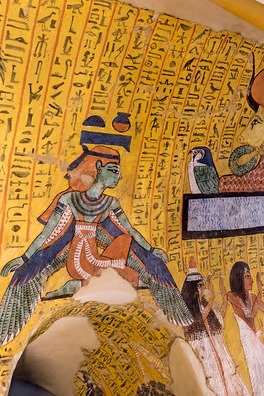The tombs of this last period of occupation of the site of Deir el-Medina are rarely decorated. Whether it was a lack of time and suitable finances, lack of qualified personnel, uncertainty and political unrest or increasing poverty of the monarchy engendering that of the workers? It seems that the progressive decadence slowed down, then almost stopped the artistic development of painters and their product.
Only the favoured, such as the chief of works Inerkhau and the foreman Hay (tomb TT267), a contemporary of Ramesses IX, seem to have had enough fortune or skill, enough authority and connections to make for themselves beautifully decorated tombs with polychromatic frescos. The rest of the corporation of craftsmen appear to have been content with chapels and chambers merely covered in a plain white-wash covering.
The period situated between the end of the reign of Ramesses III and the beginning of that of Ramesses IV was also a period of social unrest, known for the first strikes in history, motivated by the non-payment of the wages by a Pharaonic administration at a time strangled by the lack of resources in the treasury and also for being extensively corrupt.
The first tomb of Inerkhau is reduced today to its chamber and bears the number TT359: it is one of the rare tombs that the Supreme Council of Antiquities hasn't (yet) closed. It also included a forecourt, which proves to be complex as will be seen, and a decorated chapel of which nothing now remains.
Inerkhau's second tomb is TT299 and it was probably this one which was intended for Inerkhau himself, TT359 probably is meant for the use of his family. What remains of this will be examined within these pages thanks to the reports of Bernard Bruyère's excavations. These reports are exceptional and are first-hand documents of the study of both monuments


































































No comments:
Post a Comment
excellent go-ahead